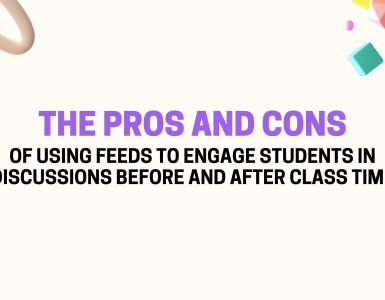Artificial Intelligence, or AI, refers to the simulation of human intelligence in machines that are programmed to think, learn, and problem-solve like humans. AI’s power lies in its ability to augment human capabilities, tackle complex problems, and improve various aspects of our lives. As it continues to evolve, its potential for positive change is immense, making it a transformative force in the modern world.

How can AI be used in class?
AI can be harnessed to enhance open-ended question management, saving valuable time when reviewing students’ inquiries. Leveraging AI capabilities can streamline instructors’ approach to addressing critical issues and providing personalized feedback to students, fostering a more efficient and productive learning environment.
When it comes to working with AI and machine learning—knowing where to start, starting small, and adding to your capabilities over time.
AI can also help educators foster greater inclusivity—AI-based language translation, for example, can enable more students with diverse backgrounds to participate in a class or listen to a lecture.
“Unleashing the Power of AI for Education.” Wired, Microsoft
Why open-ended questions?
Asking open-ended questions in class offers numerous benefits for course discord. Designing questions that foster critical thinking and problem-solving skills can encourage students to analyze problems from unconventional angles.
Open-ended questions cultivate creativity and inspire innovative thinking that leads to exploring ideas and solutions while creating a safe space for risk-taking, allowing students to express unique perspectives without fear of judgment.

Here are some of our favorite questions to try, regardless of your discipline:
- What was the most significant concept or idea you learned in today’s class? How will it impact your understanding of the subject matter going forward?
- Were there any topics or points discussed in today’s class that you found particularly intriguing or thought-provoking? Why did they capture your attention?
- Can you identify any connections or relationships between the material covered in today’s class and other topics or courses you have taken? How do these connections enhance your overall understanding?
- Were there any aspects of today’s class confusing or unclear? Is there a specific concept or idea you would like further clarification on?
- In your opinion, what were the most engaging or effective teaching methods employed during today’s class? How did they contribute to your learning experience?
- Did today’s class challenge your preconceived notions or assumptions about the topic? Can you identify any specific instances where your perspective shifted or evolved?
- Reflecting on your participation and engagement during today’s class, what strategies or techniques did you find most helpful in promoting active learning? Is there anything you would like to improve upon in future courses?
- Can you identify any real-life applications or implications of the concepts covered in today’s class? How might they relate to your future career or personal interests?
- Were there any alternative viewpoints or perspectives discussed during today’s class that you found particularly interesting or valuable? How did they contribute to your understanding of the subject matter?
- Looking ahead, what questions or areas of exploration would you like to see addressed in future classes? Are there any specific topics or subtopics you want to delve deeper into?
Open-ended questions can promote inclusivity by accommodating diverse perspectives and backgrounds and valuing all students’ contributions. Furthermore, they can inspire critical curiosity, nurture a love for learning, and encourage continuous growth beyond the classroom.

And while our community cherishes open-ended questions and feedback, evaluating students’ submissions can be time-consuming. Let’s explore ways to save you time while reviewing students’ submissions.
How to save time while reviewing open-ended submissions during or after class?
- Setting specific criteria and defining the key points or elements you seek in the submissions is essential to save time.
- Implementing technology that can assist in summarizing and analyzing submissions can cut your work. CampusKnot’s AI-powered tools can highlight important keywords, themes, and patterns, making it easier to process the content in 100 words or less.
- Prioritize sections, like the introduction and conclusion, to grasp the main ideas. Then, delve into specific areas based on your assessment needs.

Implementing these time-saving strategies can decrease the evaluation of open-ended submissions without compromising the quality of the assessment.
By combining the power of AI Summaries with open-ended questions, instructors can facilitate deeper engagement with students, encourage critical thinking, and promote active participation in the learning process. Ultimately, this integration enhances the educational experience for both students and instructors, leading to more meaningful interactions and a more enriching learning journey.
Psst… Love the first ten questions? Try these ones as well 👇
- What are the main arguments or key points made in the assigned reading? How do they contribute to our understanding of the topic?
- Were there any aspects of the reading that you found challenging or difficult to grasp? Can you identify specific areas where you would like further clarification?
- How does the assigned reading connect to or build upon the concepts covered in previous lectures or readings? Can you draw any connections or identify any contrasting viewpoints?
- Can you provide an example or real-life scenario that illustrates one of the concepts discussed in the reading? How does it enhance your understanding of the material?
- Are there any questions or points of contention that arose in your mind while reading the material? What are they, and how do they relate to the broader themes or arguments presented?
- Can you identify strengths or weaknesses in the author’s approach or argumentation? Do you agree or disagree with their perspective? Why or why not?
- How does the assigned reading contribute to the current state of knowledge in the field? Can you think of any implications or potential applications of the ideas presented?
- Are there any connections between the assigned reading and current events, societal issues, or personal experiences? How does the reading shed light on or relate to these contexts?
- Did the assigned reading challenge or change your preconceived notions or beliefs about the topic? How did it shape your understanding or perspective?
- What would it be if you were to summarize the main message or key takeaways from the reading in one sentence? How does this summary align with your overall understanding of the subject matter?
References:
Ayoub, Dan. “Unleashing the Power of AI for Education.” Wired, Microsoft, https://www.wired.com/brandlab/2020/03/unleashing-the-power-of-ai-for-education/.




